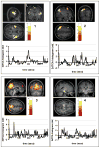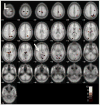Functional epileptic network in left mesial temporal lobe epilepsy detected using resting fMRI
- PMID: 19945255
- PMCID: PMC2823966
- DOI: 10.1016/j.eplepsyres.2009.10.018
Functional epileptic network in left mesial temporal lobe epilepsy detected using resting fMRI
Abstract
The purpose of this study was to determine transient functional signal activity in a small, homogeneous group of left temporal lobe epilepsy (TLE) patients, without the use of EEG; and to use one of these activated regions to identify a possible epileptogenic network across the whole brain in this group. Resting functional MRI scanning was performed on five left TLE patients who underwent selective amygdalohippocampectomy resulting in seizure control and 10 healthy control subjects. Activation maps of functional signal peaks were calculated using a data-driven analysis, 2dTCA, across the group of patients. In addition to the expected region of activation in the left anterior hippocampus, the results of the 2dTCA analysis revealed activity in the bilateral insular cortex and default-mode network which are not commonly reported using fMRI, but are supported by other electrical and functional changes. The region of activation corresponding to the anterior hippocampal region of resection (presumably the epileptogenic region) was used as a seed region for fMRI functional connectivity analysis. This revealed increased negative connectivity in the patients as compared to controls across a network including thalamic, brainstem, frontal and parietal regions consistent with theories of inhibited function in subcortical and cortical structures during ictal propagation.
Figures






Similar articles
-
Functional connectivity of the hippocampus in temporal lobe epilepsy: feasibility of a task-regressed seed-based approach.Brain Connect. 2013;3(5):464-74. doi: 10.1089/brain.2013.0150. Brain Connect. 2013. PMID: 23869604 Free PMC article.
-
Structural and functional asymmetry of medial temporal subregions in unilateral temporal lobe epilepsy: A 7T MRI study.Hum Brain Mapp. 2019 Jun 1;40(8):2390-2398. doi: 10.1002/hbm.24530. Epub 2019 Jan 21. Hum Brain Mapp. 2019. PMID: 30666753 Free PMC article.
-
Diminished default mode network recruitment of the hippocampus and parahippocampus in temporal lobe epilepsy.J Neurosurg. 2013 Aug;119(2):288-300. doi: 10.3171/2013.3.JNS121041. Epub 2013 May 24. J Neurosurg. 2013. PMID: 23706058 Free PMC article.
-
Ictal vomiting as a sign of temporal lobe epilepsy confirmed by stereo-EEG and surgical outcome.Epilepsy Behav. 2015 Dec;53:112-6. doi: 10.1016/j.yebeh.2015.10.009. Epub 2015 Nov 8. Epilepsy Behav. 2015. PMID: 26558713 Review.
-
Consciousness and epilepsy: why are complex-partial seizures complex?Prog Brain Res. 2009;177:147-70. doi: 10.1016/S0079-6123(09)17711-7. Prog Brain Res. 2009. PMID: 19818900 Free PMC article. Review.
Cited by
-
The effects of pediatric epilepsy on a language connectome.Hum Brain Mapp. 2014 Dec;35(12):5996-6010. doi: 10.1002/hbm.22600. Epub 2014 Jul 31. Hum Brain Mapp. 2014. PMID: 25082062 Free PMC article.
-
Seizure Freedom After Epilepsy Surgery and Higher Baseline Cognition May Be Associated With a Negatively Correlated Epilepsy Network in Temporal Lobe Epilepsy.Front Neurosci. 2021 Jan 18;14:629667. doi: 10.3389/fnins.2020.629667. eCollection 2020. Front Neurosci. 2021. PMID: 33584184 Free PMC article.
-
Lesion Network Localization of Seizure Freedom following MR-guided Laser Interstitial Thermal Ablation.Sci Rep. 2019 Dec 9;9(1):18598. doi: 10.1038/s41598-019-55015-y. Sci Rep. 2019. PMID: 31819108 Free PMC article.
-
Limits of 2D-TCA in detecting BOLD responses to epileptic activity.Epilepsy Res. 2011 May;94(3):177-88. doi: 10.1016/j.eplepsyres.2011.01.018. Epub 2011 Feb 25. Epilepsy Res. 2011. PMID: 21353479 Free PMC article.
-
Alterations in regional homogeneity of resting-state brain activity in mesial temporal lobe epilepsy.Epilepsia. 2013 Apr;54(4):658-66. doi: 10.1111/epi.12066. Epub 2013 Jan 7. Epilepsia. 2013. PMID: 23294137 Free PMC article.
References
-
- Addis DR, Moscovitch M, McAndrews MP. Consequences of hippocampal damage across the autobiographical memory network in left temporal lobe epilepsy. Brain. 2007;130:2327–2342. - PubMed
-
- Aghakhani Y, Kobayashi E, Bagshaw AP, Hawco C, Benar CG, Dubeau F, Gotman J. Cortical and thalamic fMRI responses in partial epilepsy with focal and bilateral synchronous spikes. Clin Neurophysiol. 2006;117:177–191. - PubMed
-
- Arnold S, Schlaug G, Niemann H, Ebner A, Luders H, Witte OW, Seitz RJ. Topography of interictal glucose hypometabolism in unilateral mesiotemporal epilepsy. Neurology. 1996;46:1422–1430. - PubMed
-
- Bertram EH, Mangan PS, Zhang D, Scott CA, Williamson JM. The midline thalamus: alterations and a potential role in limbic epilepsy. Epilepsia. 2001;42:967–978. - PubMed
Publication types
MeSH terms
Grants and funding
LinkOut - more resources
Full Text Sources

